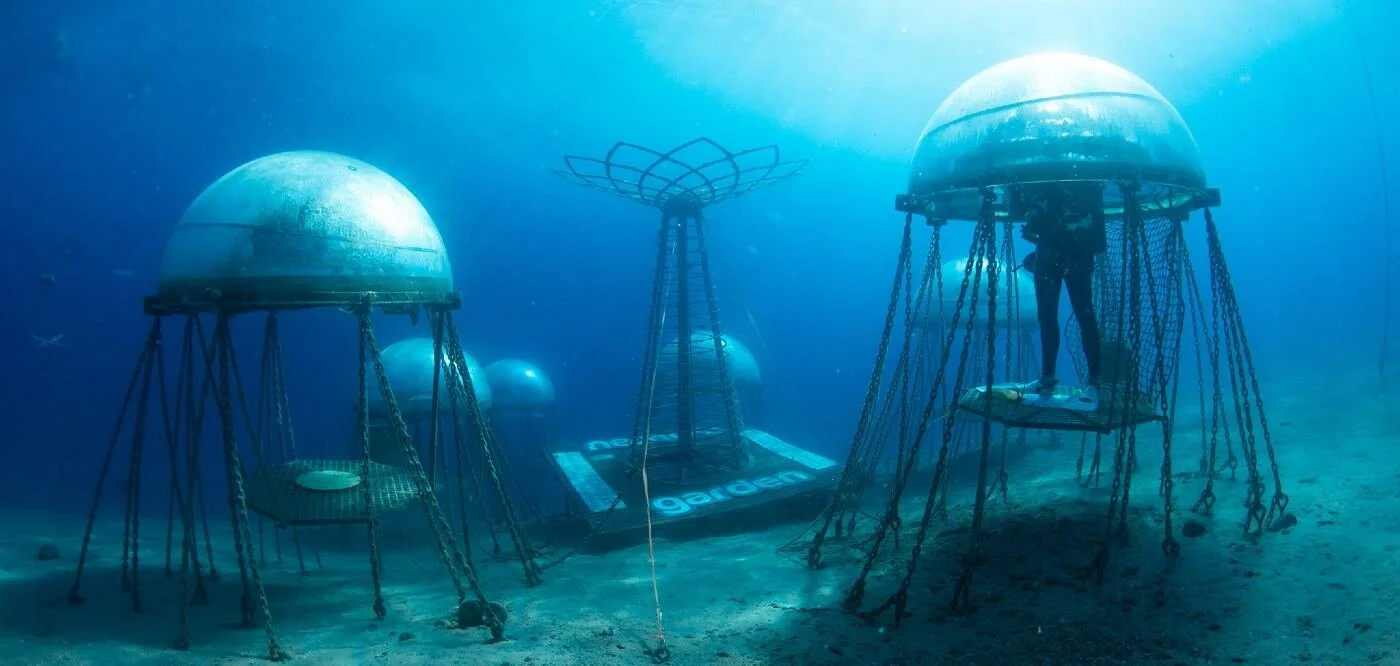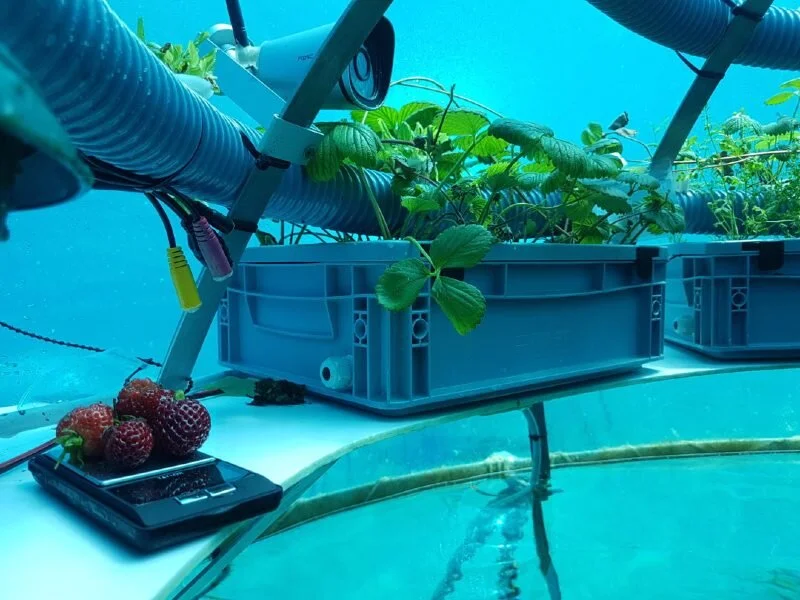
Welcome to iGrow News, Your Source for the World of Indoor Vertical Farming
World’s First Underwater Vegetable Garden Reopens Growing Lettuce And Basil In Perfect Temperature
From the ancient rice terraces of Yunnan to modern vertical hydroponics, agriculture comes in many different forms. Now a group of Italian brainiacs have created the world’s first underwater garden for terrestrial plants
By Andy Corbley
July 13, 2021
From the ancient rice terraces of Yunnan to modern vertical hydroponics, agriculture comes in many different forms. Now a group of Italian brainiacs have created the world’s first underwater garden for terrestrial plants.
Seaweed and kelp have been cultivated along shorelines for centuries, but in small submersible glass domes, pots of basil, lettuce, tomatoes, and even zucchini flowers, green peas, aloe vera, and mushrooms are growing like in any other home garden.
Called Nemo’s Garden, the project was launched by the Ocean Reef Group as a means to experiment with food supply diversity, should climatic changes make parts of Italy too dry to farm.
The large self-sustaining, totally-contained biospheres would in theory be scalable, and perhaps in the future might look like the underwater city from Star Wars: The Phantom Menace.
The challenges inherent in growing plants underwater, given that they are normally at home in soil, was but one hurdle Nemo has had to overcome. The six air-filled greenhouses (or should that be bluehouses?) suffered major storm damage in October 2019, and before they could be fully repaired, COVID-19 had all the researchers sheltering in place.
Yet the team never gave up hope, as Euronews reports, and the months of abandonment did not harm the facility in any way. June 6th saw the garden fully-operational again, including their livestream where one can watch the plants literally grow.
The biospheres, which sit eight meters under the surface off the coast of Noli in Liguria, use solar energy for their minimal electrical needs, and evaporated seawater condenses on the glass of the ceiling which waters the plants. A diver swims under and up into the air pocket of the pod to harvest what’s ready to eat.
The project website says that increased pressure like that found under the ocean is actually beneficial to the speed at which plants can germinate, though they admit very little research has been published on the topic—after all, not so many people are currently trying to grow strawberries underwater.
The conditions create a really intense flavor in the vegetables, and also allow the plants’ environment to be completely controlled, with nothing impacting their life that the growers don’t want.
Nemo’s Garden, OceanReef
For now Nemo’s Garden is essentially a research lab, but if the idea were expanded, it’s expected to be able to reinforce food security for the peninsula, and the world.
(SEE Inside Nemo’s Garden in the video below.)
Paris Is Turning Abundant Car Parks Into Underground Farms
Falling ownership in car sales in Paris has increased the space of abandoned car parks in the city. This venture has taken a green turn as the city is transforming old car parks to grow mushrooms or even salad
Falling ownership in car sales in Paris has increased the space of abandoned car parks in the city. This venture has taken a green turn as the city is transforming old car parks to grow mushrooms or even salad.
Paris had built too many underground car parks in the 1960s and 70s, when the city tried to keep with the mushrooming housing blocks, building underground parking for residents hence became inevitable.
Sources allege, beneath Paris there are millions of square meters of car park. Figures however allege, a steady decline in car ownership in Paris, a trend which city authorities are keen to encourage. The drop in the number of car owners is also attributed to the new, convenient cab and bike services to move around the city.
As a result, some of the car parks find themselves surplus to the requirements. The city is hence calling for new ideas which can transform Paris’s underground to reveal its full potential. A number of competitions have taken place with this focus.
Urban farmers - Cycloponics were selected as one of the winners for rejuvenating three car parks in Paris. One of their projects was the redundant La Chapelle, a no-go area used by drug dealers and prostitutes. The space now is however blooming. The group made the space conducive for cultivating main crop: oyster, shiitake and white button mushrooms. They also grow chicory, a northern French delicacy that grows in the dark.
The produced harvest is sold through nearby organic grocery stores, which also means urban food is grown and consumed within a short distance. This method also reduces the pollution that comes along with the transportation.
In France there are a lot of regulations around operating a business underground not least for security reasons. Other businesses have been rejected for applications. Permits for such kind of farming have however been possible.
The city’s car parks are as a result experiencing a green makeover.
Posted in Environment, NewsTagged Paris, underground farms
Growing Herbs And Vegetables Under The Sea
Near Genoa, Italy
Underwater agriculture might be one of the solutions to help eradicate world food shortages. That is the idea behind the latest project of the Ocean Reef Group in Italy. According to the Food and Agriculture Organization, at present only some 11 percent of the globe's land surface (13.4 billion ha) is used in crop production.
As the world population is expected to grow from 7.6 billion to 9.8 billion in 2050, according to the United Nations, using water, which covers about 75% of the world surface, could help enormously. That is why the marketing manager of the research group Luca Gamberini and his team have set out to prove it is possible to grow herbs and vegetables under the sea.
In the video below we visit the first underwater farm in the coastal waters near Genoa, Italy.
Source: euronews.com
Publication date: 7/17/2018
Italian Agrinauts Develop Underwater Greenhouses
Controlled-environment agriculture has pushed the boundaries, making it possible to grow crops in the most unlikely of locations. We've already seen cultivation take root on the North Pole, in space, and underground. An Italian scuba enthusiast adds another dimension to the list: underwater greenhouse
Italian Agrinauts Develop Underwater Greenhouses
Controlled-environment agriculture has pushed the boundaries, making it possible to grow crops in the most unlikely of locations. We've already seen cultivation take root on the North Pole, in space, and underground. An Italian scuba enthusiast adds another dimension to the list: underwater greenhouses.
The history of Nemo’s Garden begins in the Noli’s Bay in 2012, when Mr. Sergio Gamberini, President of Ocean Reef Group, came up with this funky idea, trying to combine two of his passions: scuba diving and gardening.
The first experiment, project coordinator Gianni Fontanesi tells us, was conducted during the summer of 2012, with one very small biosphere anchored to the sea bottom in which green basil was planted and successfully grew. In this structure no “agrinauts” could get inside.
From herbs to stevia
The Nemo's Garden team already tested many different plants: green basil, oregano, sage, mint, thyme and other herbs, various types of salads, tomatoes, beans, peas, zucchini, and goji berries. They don't just limit themselves to edible plants, however - examples of medical and cosmetic crops include stevia, melissa, calendula, aloe vera, etc.
"Our target is not selling veggies/herbs on the market", Gianni says. "Indeed, we are not focused on fixing a price for a kg of plants. Our goal now is to investigate which plant is growing better, together with the fresh water production and the complete auto sustainability of the system. Product maximization will be the next step."
New and traditional techniques
"The unique conditions inside the biospheres (especially higher pressure and high level of humidity) are acting positively on the plants' growth", according to Gianni. He says they've noticed a faster germination and different chemical compositions with different composition of essential oils.
Being underwater requires new ideas and solutions, but the agrinauts are also adapting common growing methods, albeit in a completely different environment. For instance, one winter the team tested a few LED lights that could be used during the low season when the sunlight is reduced and the day are short.
Although Nemo's Garden borrows certain techniques from 'land growers', the agrinauts want to work with their colleagues on terra firma, not against them. "We get positive feedback from all over the world, from many different realities", Gianni says, emphasizing: "We do not want to compete with conventional growers, that is not our goal."
Customized underwater structures
Nemo’s Garden is a pilot project created and entirely sponsored by Ocean Reef Group. The company manufactures diving equipment, snorkeling full face masks (inventors), protection equipment, and electronics. "The other projects are related to the different activities we are running", Gianni tells us.
Right now, the team at Nemo's Garden is still investigating which crop grows better, together with fresh water production/collection and self-sustainability of the system. They also have ambitious plans for the future.
"We are now ready to replicate this underwater habitat or to create customized options. Through the years we understood the many possible applications for this type of habitat: not only an underwater greenhouse, but an underwater observatory, an uw lab with a higher pressure, a new touristic attraction." They're receiving requests from all over the world, and have already installed one biosphere at the TODI center in Belgium.
For more information:
Nemo's Garden
www.nemosgarden.com
Publication date: 3/27/2018
Author: Jan Jacob Mekes
Copyright: www.hortidaily.com










